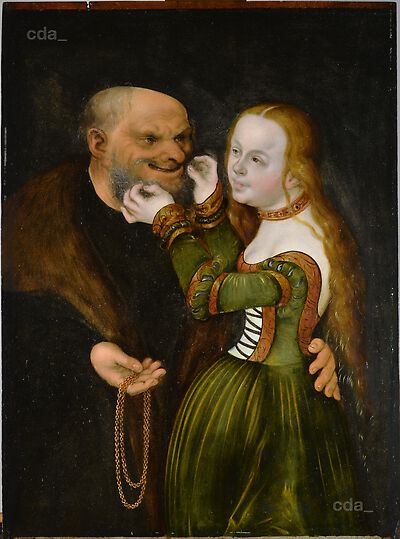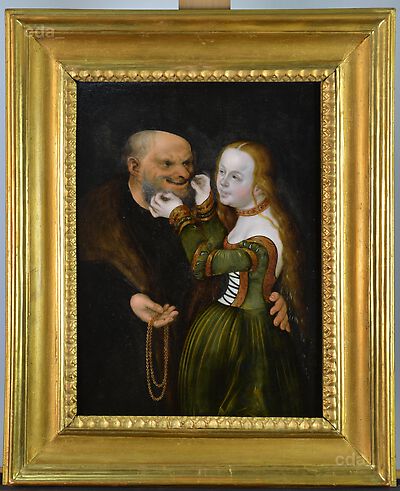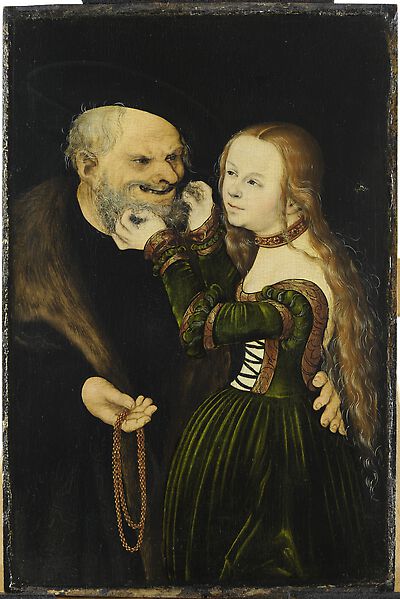- Attributions
-
Circle of Lucas Cranach the Elder
Workshop Lucas Cranach the Elder
Attributions
| Circle of Lucas Cranach the Elder | 'School of Lucas Cranach the Elder' [Frimmel 1894, No. 246] [Csaki 1901, No. 208] [Csaki 1909, No. 218] [Ionescu 1964, 20, No. 208] |
| Workshop Lucas Cranach the Elder | [Sonoc, Muzeul National Brukenthal, revised 2017] [Tarangul 1966, 343] |
| Lucas Cranach the Elder | [Schade, Gronau 1973, 65, No. 95] |
- Production date
- after 1530
Production date
| after 1530 | [Sonoc, Muzeul National Brukenthal, revised 2017] |
- Dimensions
- Dimensions of support: 37.4 x 27.6 cm
Dimensions
Dimensions of support: 37.4 x 27.6 cm
Dimensions of the painted surface: 36.5 x 27.6 cm
Dimensions including frame: 52 x 42 x 4 cm
[Sonoc, Muzeul National Brukenthal, revised 2017]
- Signature / Dating
None
- Inscriptions and Labels
None Reverse of the panel: - bottom left: paper label: written in red: '218' (current inventory number); old Brukenthal …
Inscriptions and Labels
Inscriptions, Badges:
None
Stamps, Seals, Labels:
Reverse of the panel: - bottom left: paper label: written in red: '218' (current inventory number); old Brukenthal Museum seal (used prior to 1948); printed in purple China ink: 'S(ammlung) B(aron) B(rukenthal'sches) M(useum)'.
Frame:
- top left: an identical label
Reverse of the panel:
- painted black inscription: 'MB / 218'. This inscription cannot be dated earlier than 1909, as this inventory number was allocated in 1909.
- top half, centre: paper label: handwritten in black ink (iron gall): ' D(eutsche). Schule / 23. 246.'
- left top corner: paper label: typewritten (in both Rumanian and German): Scoala lui / LUCAS CRANACH c. B. / 1472-1553 / Sc. germana// Nr. Tab. 218 / Depozitul / Raftul // (Barbat?) batrân si femeie tânara / Alter Mann und junge Frau / Pictura pe lemn de arin / Dimensiuni: In. 0,37 lt. 0,28 Starea: Rest. 1897 (i. e.: The School of Lucas Cranach the Elder/ 1472-1553 / German School// Tab. No. 218 / Store / Shelf // Old Man and Young Woman / Painting on alder wood / Dimensions: Height 0.37 Width 0.28 Condition: Restored 1897)
Frame:
- handwritten in red ball-point pen: 'S 637' (an old inventory number), now allocated to a sculpture in the museum's collection. Thus the painting only acquired the present frame recently. Recent annotations on the wooden frame: '149' (in pencil) and '218' (in blue pencil).
[Sonoc, Muzeul National Brukenthal, revised 2017]
- Owner
- Muzeul National Brukenthal
- Repository
- Muzeul National Brukenthal
- Location
- Sibiu
- CDA ID
- RO_MNB_218
- FR (1978) Nr.
- FR-none
- Persistent Link
- https://lucascranach.org/en/RO_MNB_218/






